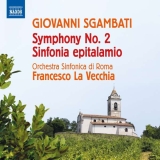Giovanni Sgambatis jahrzehntelang verschollene, viersätzige Zweite Symphonie wurde für diese Aufnahme in der von Rosalind Trübger rekonstruierten Aufführungsfassung eingespielt.
Die Symphonie Nr. 2 blieb unveröffentlicht und wurde zu Lebzeiten des Komponisten nie vollständig aufgeführt. Im Laufe des 20. Jahrhunderts ging dann die vollständige Partitur verloren, so dass die Symphonie in Vergessenheit geriet, bis Trübger 2003 mit der Rekonstruktion der Partitur anhand der handschriftlichen Orchesterstimmen begann und 2006 die erste Ausgabe veröffentlichte.
Es ist ein ideenreiches, abwechslungsreiches Werk, das mit einem romantischen Andante sostenuto beginnt, danach aber recht lebendig, leicht und beschwingt wird. Ich glaube, dass man diese Symphonie noch vitaler und kraftvoller spielen könnte, als sie hier erklingt.
Die etwa gleich lange, 38 Minuten dauernde Sinfonia epitalamio, Sgambatis letzte symphonische Komposition, wurde am 12. September 1888 in Turin anlässlich der Hochzeit des Herzogs Amedeo d’Aosta mit Prinzessin Letizia Bonaparte aufgeführt.
Der erste Teil, In Chiesa, ist feierlich und lyrisch. Der zweite Teil, In Giardino, beschreibt ein Volksfest, auf das ein Notturno folgt, dann die Reprise und der Tanz der Kinder.
Der dritte Teil, In Corte, beginnt mit einem neobarocken Minuetto, gefolgt von einem feierlichen Aufzug, der die Komposition pompös abschließt.
Das Orchestra Sinfonica di Roma bietet unter Francesco La Vecchia eine akkurate Interpretation eines Werks, das ich mir freilich ebenfalls etwas charakteristischer und spannender vorstellen kann.
Giovanni Sgambati’s four-movement Second Symphony, lost for decades, was recorded for this recording in the performance version reconstructed by Rosalind Trübger.
Symphony No. 2 remained unpublished and was never performed in its entirety during the composer’s lifetime. Then, during the 20th century, the complete score was lost and the symphony was forgotten until Trübger began reconstructing the score from the handwritten orchestral parts in 2003 and published the first edition in 2006.
It is an imaginative, varied work that begins with a romantic Andante sostenuto but becomes quite lively, light, and upbeat thereafter. I believe that this symphony could be played with even more vitality and power than it is heard here.
The Sinfonia epitalamio, about the same length and 38 minutes long, Sgambati’s last symphonic composition, was performed in Turin on September 12, 1888, on the occasion of the wedding of Duke Amedeo d’Aosta to Princess Letizia Bonaparte.
The first part, In Chiesa, is solemn and lyrical. The second part, In Giardino, describes a folk festival, followed by a nocturne, then the recapitulation and the dance of the children.
The third part, In Corte, begins with a neo-baroque minuetto, followed by a solemn elevator that concludes the composition pompously. The Orchestra Sinfonica di Roma, under Francesco La Vecchia, offers an accurate interpretation of a work that I can admittedly also imagine being a bit more characteristic and exciting.
























